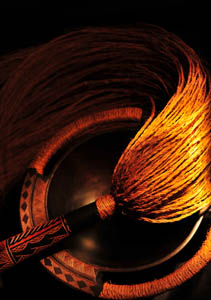After tackling such a difficult topic in my last entry on the toxic part of the kava plant, it was refreshing to read about the opening ceremony of the Festival of Pacific Arts in Samoa last week. These ceremonial rituals include traditional kava ceremonies.
In Pacific Magazine, they described how “both men and women, young and old, played their respective roles in the official welcome ceremony for delegates to the Tenth Festival of Pacific Arts in American Samoa.
While the men were busy preparing for the ava ceremony (kava ceremony), the women were getting ready to display their finely woven mats.
Boys and girls also pitched in, taking their place beside their elders to help in welcoming guests to their shores.
Despite a downpour during the ceremony, the beautiful array of colorful outfits worn by the hosts and different groups from participating countries brightened the ceremony and kept spirits high. Men in traditional dress took part in the ava ceremony after which women displayed their fine weaving.”
I found the description of the traditional ceremonies for men and women to be very enlightening:
“As is the tradition, the first cup of ava was poured on the ground to mark appreciation and respect for the earth, the provider of wealth and good health.
Each guest of honor was presented with a coconut shell filled with ava as a sign of welcome. All the delegations were then offered a dried root of the ava plant as a token of appreciation from the hosts.
Wearing traditional American Samoan dress made from woven pandanus, Kalasa Atuatasi, wife of a local matai (chief), led the women’s ceremony with a Samoan chant.
The women proceeded to offer guests gifts of finely woven pandanus mats in an age-old custom called ‘fa’alelega-pepe’. The mats, woven by women from all over the territory, were presented to each participating country as a mark of respect and welcome.
Atuatasi said the custom of ‘fa’alelega-pepe’ involves women who weave the fine mats in preparation for a ceremony fit for a king. The finely woven mats used to be the main currency of the people of the land before dollars and cents were introduced.
‘The value of the mats depends on how finely they are woven and how old they are, or how many hands they have passed through. When we present the fine mats we chant in our native tongue, praising the work that has been done and saying thank you for them.’ The tradition of ‘fa’alelega’ is passed from one generation to the next.”
The following passage on government support dedicated to keeping these traditions alive gives me hope.
“Despite not having village societies to help preserve some of these practices, the island is lucky because the government has allocated funds to help preserve customs and traditions. Although there are certain things that change, the value of these mats remains. You can’t avoid change. Some things are replaced with more modern things but the value behind why we continue these customs still remains. The important thing is to keep the value of our cultures intact.”
Amazing is the time and effort these mats require. The work on the mats presented at the opening ceremony was initially begun four years ago, just after the last Festival of Pacific Arts in Palau in 2004. Because so much time and effort is put into making the mats, they are held in high esteem and are valued – they are presented to guests as a token of appreciation.
I also read a quick interview in the Columbus Ledger-Enquirer from Columbus, Georgia, U.S.A. (of all places!) with a general manager of a resort in the Fiji Islands. Here is an excerpt from the Q & A by John Bordsen.
“Q. I’m calling from the Eastern U.S. at 5 p.m.; where you are, it’s 9 the following morning. Does this get disorienting?
A. Frequently. It’s almost bizarre to see what is happening all over the world – the urgency and the drama – and then look out the window and see coconut trees, and smiling Fijians laughing and drinking kava.
Q. Kava?
A. It’s a drink made from the root of a family of the pepper plant. They grow it in the hills of Fiji. After five years, the plant is dug up and the roots are dried and pounded into a sort of powder that’s mixed with water. This kava is poured into a half-coconut and passed around to people sitting in a circle. It’s kind of the Fijians’ Jack Daniels.
Some countries prohibit the import of it, but kava is commercially available here in Fiji. You can grow it yourself or go to some of the local open-air markets and buy the roots, take them home, pound it up and drink it.
Q. So it’s liquor?
A. There’s no alcohol, but a mix between a mild sedative and very slight hallucinogen. It’s legal. You’ll often go into government offices and see the police – or other people who are supposed to be razor-sharp – sitting around having a few bowls of kava. It’s very much a part of the society.
Q. What does it taste like?
A. Muddy water.”
HA! That last line made me giggle! It does indeed sometime taste like muddy water. It all depends on what you mix it with. My favorite is coconut milk with mango juice. Yum!
Until next time!
Aloha no!
Makaira






